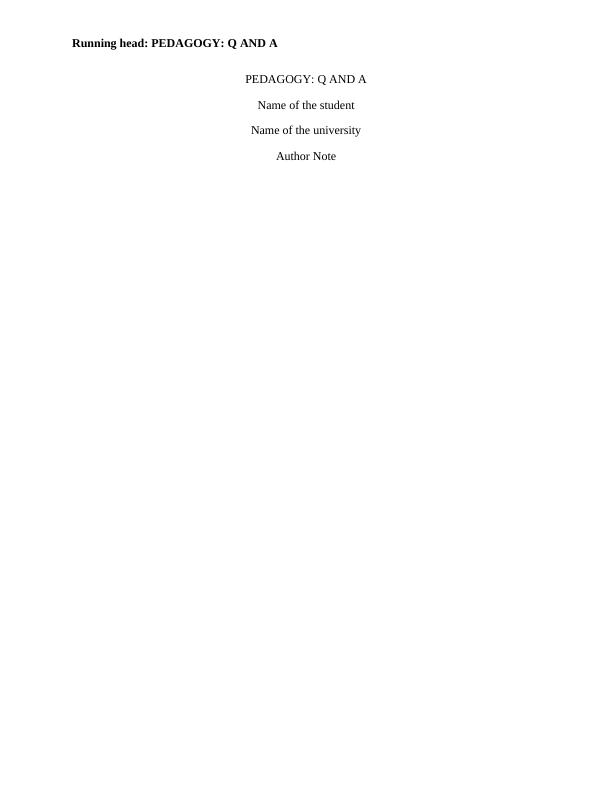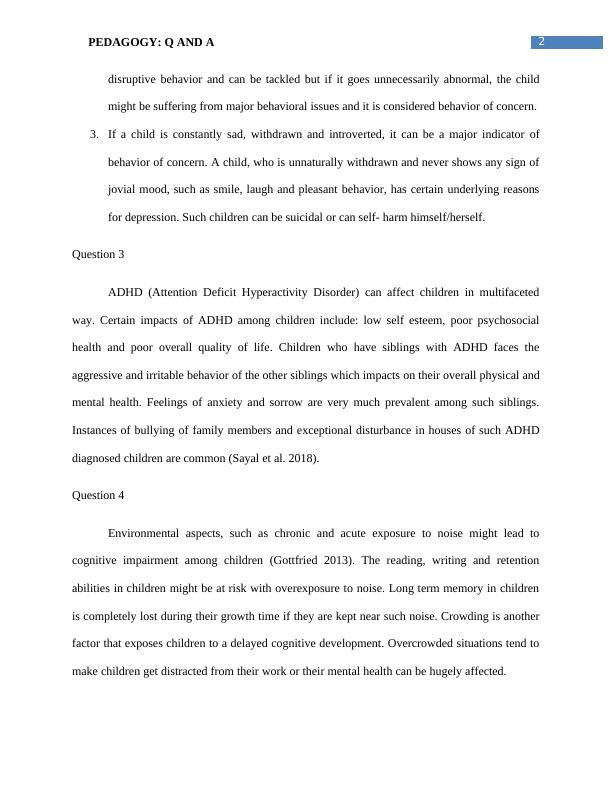Pedagogy | Disruptive Behavior Disorder - Q&A
Added on 2022-08-12
6 Pages1231 Words17 Views
Running head: PEDAGOGY: Q AND A
PEDAGOGY: Q AND A
Name of the student
Name of the university
Author Note
PEDAGOGY: Q AND A
Name of the student
Name of the university
Author Note

1PEDAGOGY: Q AND A
Question 1
Disruptive behavior disorder (DBD) is a condition where children repeatedly show
ongoing patterns of uncooperative and obstinate behavior. Disruptive behavior disorder patterns
can range from indifference to hostility (Quay and Hogan 2013). Their disruptive behavior
disorder also affects hugely to the people who be around them, such as, teachers, peers,
caregivers and family members. Children who have been diagnosed with such disorders can be
stubborn, unnecessarily obstinate, disobedient and irritable in nature. On the other hand, behavior
of concern can be described as when someone (preferably children) does things that hurt
themselves, other people or things (Graham and Reynolds 2013). While comparing behavior of
concern with disruptive behavior, it is not necessary that behavior of concern would be
disruptive in nature. Rather, it could be somewhere in the middle of indifference and hostility
which makes a child unpredictable and vulnerable.
Question 2
A disruptive behavior becomes a behavior of concern when
1. the child crosses the ethical limitations of misconduct, which means, from behavioral
and psychological manifestation of aggressiveness, they become physically aggressive
which can harm his/her caregivers, family, teachers and peers. Such incidents happen
when a child goes through Conduct Disorder (CD).
2. When a child indicates an abnormal uncooperative attitude towards his/her mothers,
fathers or caregivers in the simple day-to-day activities such as eating meals, going to the
bed, doing homework or school works and so on. Uncooperative attitude is a part of
Question 1
Disruptive behavior disorder (DBD) is a condition where children repeatedly show
ongoing patterns of uncooperative and obstinate behavior. Disruptive behavior disorder patterns
can range from indifference to hostility (Quay and Hogan 2013). Their disruptive behavior
disorder also affects hugely to the people who be around them, such as, teachers, peers,
caregivers and family members. Children who have been diagnosed with such disorders can be
stubborn, unnecessarily obstinate, disobedient and irritable in nature. On the other hand, behavior
of concern can be described as when someone (preferably children) does things that hurt
themselves, other people or things (Graham and Reynolds 2013). While comparing behavior of
concern with disruptive behavior, it is not necessary that behavior of concern would be
disruptive in nature. Rather, it could be somewhere in the middle of indifference and hostility
which makes a child unpredictable and vulnerable.
Question 2
A disruptive behavior becomes a behavior of concern when
1. the child crosses the ethical limitations of misconduct, which means, from behavioral
and psychological manifestation of aggressiveness, they become physically aggressive
which can harm his/her caregivers, family, teachers and peers. Such incidents happen
when a child goes through Conduct Disorder (CD).
2. When a child indicates an abnormal uncooperative attitude towards his/her mothers,
fathers or caregivers in the simple day-to-day activities such as eating meals, going to the
bed, doing homework or school works and so on. Uncooperative attitude is a part of

2PEDAGOGY: Q AND A
disruptive behavior and can be tackled but if it goes unnecessarily abnormal, the child
might be suffering from major behavioral issues and it is considered behavior of concern.
3. If a child is constantly sad, withdrawn and introverted, it can be a major indicator of
behavior of concern. A child, who is unnaturally withdrawn and never shows any sign of
jovial mood, such as smile, laugh and pleasant behavior, has certain underlying reasons
for depression. Such children can be suicidal or can self- harm himself/herself.
Question 3
ADHD (Attention Deficit Hyperactivity Disorder) can affect children in multifaceted
way. Certain impacts of ADHD among children include: low self esteem, poor psychosocial
health and poor overall quality of life. Children who have siblings with ADHD faces the
aggressive and irritable behavior of the other siblings which impacts on their overall physical and
mental health. Feelings of anxiety and sorrow are very much prevalent among such siblings.
Instances of bullying of family members and exceptional disturbance in houses of such ADHD
diagnosed children are common (Sayal et al. 2018).
Question 4
Environmental aspects, such as chronic and acute exposure to noise might lead to
cognitive impairment among children (Gottfried 2013). The reading, writing and retention
abilities in children might be at risk with overexposure to noise. Long term memory in children
is completely lost during their growth time if they are kept near such noise. Crowding is another
factor that exposes children to a delayed cognitive development. Overcrowded situations tend to
make children get distracted from their work or their mental health can be hugely affected.
disruptive behavior and can be tackled but if it goes unnecessarily abnormal, the child
might be suffering from major behavioral issues and it is considered behavior of concern.
3. If a child is constantly sad, withdrawn and introverted, it can be a major indicator of
behavior of concern. A child, who is unnaturally withdrawn and never shows any sign of
jovial mood, such as smile, laugh and pleasant behavior, has certain underlying reasons
for depression. Such children can be suicidal or can self- harm himself/herself.
Question 3
ADHD (Attention Deficit Hyperactivity Disorder) can affect children in multifaceted
way. Certain impacts of ADHD among children include: low self esteem, poor psychosocial
health and poor overall quality of life. Children who have siblings with ADHD faces the
aggressive and irritable behavior of the other siblings which impacts on their overall physical and
mental health. Feelings of anxiety and sorrow are very much prevalent among such siblings.
Instances of bullying of family members and exceptional disturbance in houses of such ADHD
diagnosed children are common (Sayal et al. 2018).
Question 4
Environmental aspects, such as chronic and acute exposure to noise might lead to
cognitive impairment among children (Gottfried 2013). The reading, writing and retention
abilities in children might be at risk with overexposure to noise. Long term memory in children
is completely lost during their growth time if they are kept near such noise. Crowding is another
factor that exposes children to a delayed cognitive development. Overcrowded situations tend to
make children get distracted from their work or their mental health can be hugely affected.

End of preview
Want to access all the pages? Upload your documents or become a member.
